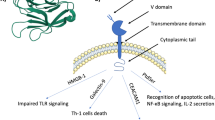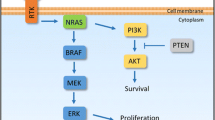Summary
there is increasing evidence to suggest that alkylation of guanine residues in DNA at the O6 position is the critical cytotoxic event following treatment with dacarbazine (DTIC) and related drugs and that endogenous O6-alkylguanine-DNA alkyltransferase (ATase) gene expression may be a major factor in resistance to such agents. 1-p-Carboxyl-3,3-dimethylphenyltriazene (CB 10-277) was recently selected for clinical evaluation as a DTIC analogue with improved solubility, stability and (possibly) metabolic activation. Serial ATase levels were measured in peripheral blood lymphocytes of nine patients and in biopsied melanoma samples of two patients undergoing treatment with 24-h continuous infusion of CB 10-277 (12 g/m2). Wide individual variations in pre-treatment levels as well as in the post-treatment depletion of lymphocyte ATase were seen. Progressive depletion of lymphocyte ATase was seen during continuous infusion of CB 10-277 in all patients. Complete suppression of lymphocyte ATase activity occurred in two patients whose pre-treatment ATase levels were low. Immediately following completion of the CB 10-277 infusion, the median ATase activity was 17% of pre-treatment levels (range, 0–67%). At 24 h after the end of the infusion, no recovery of lymphocyte ATase activity was observed in six patients, but significant recovery to 50%, 100% and 102% of pre-treatment activity occurred in the other three. In three patients who returned for subsequent cycles of chemotherapy at 4 weeks after the first dose, pre-treatment ATase levels showed a 3-to 4-fold increase relative to the original pre-treatment values. A significant correlation was found between the extent of ATase depletion and the initial lymphocyte ATase levels (r=0.725,P<0.05). Haematological toxicity developed in two patients and was associated with low pre-treatment ATase activity. Depletion of tumour ATase activity was noted in these patients, with residual activity amounting to 8% and 11% of pre-treatment levels, respectively, in the biopsied melanoma tissues. These results indicate extensive metabolism of CB 10-277 to a methylating agent capable of mediating alkylation of DNA and subsequent depletion of lymphocyte and tumor ATase levels and further indicate that the effects on lymphocytes may reflect effects on the target tumour.
Similar content being viewed by others
Abbreviations
- ATase:
-
O6-alkylguanine-DNA alkyltransferase
- CB 10-277:
-
1-p-carboxyl-3,3-dimethylphenyltriazene
- DTIC:
-
dacarbazine, 5-(3,3-dimethyl-1-triazeno)imidazole-4-carboxamide
- MTIC:
-
5-(3-methyl-1-triazeno)imidazole-4-carboxamide
References
Aamdal S, Lee SM, Radford JA, Thatcher N, Calabresi F, Israels SP, Kerger J, Stamatakis L, Kleeberg UR, Brocker E, Gerard B (1991) Sequential administration of dacarbazine (DTIC) and fotemustine in disseminated melanoma. Proc Am Assoc Cancer Res 32: 191
Balch CM, Houghton A, Peters L (1989) Cutaneous melanoma. In: De Vita VT, Hellman S, Rosenberg SA (eds) Cancer: principles and practice of oncology. J. B. Lippincott, Philadelphia, p 1522
Bignami M, Terlizzese M, Zijno A, Calcagnile A, Frosima G, Abbondandolo A, Dogliotti E (1987) Cytotoxicity, mutations and SCEs induced by methylating agents are reduced in CHO cells expressing an active mammalian O6-methylguanine-DNA methyltransferase gene. Carcinogenesis 8: 1417
Bodell WJ (1990) Molecular dosimetry for sister-chromatid exchange induction and cytotoxicity by monofunctional and bifunctional alkylating agents. Mutat Res 233: 203
Bøyum A (1968) Isolation of mononuclear cells and granulocytes from human blood. Scand J Clin Lab Invest 21: 77
Bradford MM (1976) A rapid and sensitive method for the quantitation of microgram quantities of protein utilising the principle of protein-dye binding. Anal Biochem 72: 248
Brennand J, Margison GP (1986) Reduction of the toxicity and mutagenicity of alkylating agents in mammalian cells harboring theEscherichia coli alkyltransferase gene. Proc Natl Acad Sci USA 83: 6292
Catapano CV, Broggini M, Erba E, Ponti M, Mariani L, Citti L, D'Incalci M (1987) In vitro and in vivo methazolostone-induced DNA damage and repair in L1210 leukemia sensitive and resistant to chloroethylnitrosoureas. Cancer Res 47: 4884
Clark PC (1976) The evolution of therapy for malignant melanoma at the University of Texas M. D. Anderson Hospital and Tumour Institute 1950 to 1975. Pigm Cell 2: 365
Colombo T, D'Incalci M (1984) Comparison of the tumour activity of DTIC and 1-p-(3,3-dimethyl-1-triazeno) benzoic acid potassium salt on murine transplantable tumors and their hematological toxicity. Cancer Chemother Pharmacol 13: 139
D'Incalci M, Citti L, Taverna P, Catapano CV (1988) Importance of DNA repair enzyme O6-alkyltransferase (AT) in cancer chemotherapy. Cancer Treat Rev 15: 279
Ding R, Ghosh K, Eastman A, Bresnick E (1985) DNA-mediated transfer and expression of a human DNA repair gene that demethylates O6-methylguanine. Mol Cell Biol 5: 3293
Dolan ME, Corsico CD, Pegg AE (1985) Exposure of HeLa cells to O6-alkylguanines increases sensitivity to the cytotoxic effects of alkylating agents. Biochem Biophys Res Commun 132: 178
Dolan ME, Norbeck L, Clyde C, Hora NK, Erickson LC, Pegg AE (1989) Expression of mammalian O6-alkylguanine-DNA alkyltransferase in a cell line sensitive to alkylating agents. Carcinogenesis 10: 1613
Dolan ME, Mitchell RB, Mummert C, Moschel RC, Pegg AE (1991) Effect of O6-benzylguanine analogues on sensitivity of human tumor cells to the cytotoxic effects of alkylating agents. Cancer Res 51: 3367
Foster BJ, Newell DR, Lunn JM, Jones M, Calvert AH (1990) Correlation of dacarbazine and CB 10-277 activity against human melanoma xenografts with O6-alkyltransferase. Proc Am Assoc Cancer Res 31: 401
Gerson SL, Miller K, Berger NA (1985) O6-alkylguanine-DNA alkyltransferase activity in myeloid cells. J Clin Invest 76: 2106
Gerson SL, Trey JE, Miller K (1988) Potentiation of nitrosourea cytotoxicity in human leukemic cells by inactivation of O6-alkylguanine-DNA alkyltransferase. Cancer Res 48: 1521
Gibson NW, Hartley JA, Barnes D, Erickson LC (1986) Combined effects of streptozotocin and mitozolomide against four human cell lines of the Mer+ phenotype. Cancer Res 46: 4995
Gibson NW, Hartley J, La-France RJ, Vaughan K (1986) Differential cytotoxicity and DNA-damaging effects produced in human cells of the Mer+ and Mer− phenotypes by a series of alkyltriazenylimidazoles. Carcinogenesis 7: 259
Hayward IP, Parsons PG (1984) Comparison of virus reactivation, DNA base damage, and cell cycle effects in autologous melanoma cells resistant to methylating agents. Cancer Res 44: 55
Jelinek J, Kleibl K, Dexter TM, Margison GP (1988) Transfection of murine multi-potent haemopoietic stem cells with anE. coli DNA alkyltransferase gene confers resistance to the toxic effects of alkylating agents. Carcinogenesis 9: 81
Kataoka H, Hall J, Karran P (1986) Complementation of sensitivity to alkylating agents inEscherichia coli and Chinese hamster cells by expression of a cloned bacterial repair gene. EMBO J 5: 3195
Lee SM, Thatcher N, Margison GP (1991) O6-Alkylguanine-DNA alkyltransferase depletion and regeneration in human peripheral lymphocytes following dacarbazine and fotemustine. Cancer Res 51: 619
Lee SM, Rafferty JA, Elder RH, Fan C-Y, Bromley M, Harris M, Thatcher N, Potter PM, Altermatt HJ, Perinat-Frey T, Cerny T, O'Connor PJ, Margison GP (1992) Immunohistological examination of the inter- and intracellular distribution of O6-alkylguanine-DNA alkyltransferase in human liver and melanoma. Br J Cancer 66, 355
Lee SM, Thatcher N, Margison GP (1992) Dosage and cycle effects of dacarbazine (DTIC) and fotemustine on O6-alkylguanine-DNA alkyltransferase in human peripheral lymphocytes. Br J Cancer (in press)
Lunn JM, Harris AL (1988) Cytotoxicity of 5-(3-methyl-1-triazeno)imidazole-4-carboxamide (MTIC) on Mer+, Mer+ Rem−, and Mer− cell lines: differential potentiation by 3-acetamidobenzamide. Br J Cancer 57: 54
Maynard K, Parsons PG, Cerny T, Margison GP (1989) Relationships among cell survival, O6-alkylguanine-DNA alkyltransferase activity, and reactivation of methylated adenovirus 5 and herpes simplex virus type 1 in human melanoma cell lines. Cancer Res 49: 4813
Meer L, Janzer RC, Kleihues P, Kolar GF (1986) In vivo metabolism and reaction with DNA of the cytostatic agent, 5-(3,3-dimethyl-1-triazeno)imidazole-4-carboxamide (DTIC). Biochem Pharmacol 35: 3243
Newell DR, Foster B, Carmicheal J, Harris AL, Jenns K, Gumbrell L, Calvert H (1990) Clinical studies with thep-carboxyl dimethyl phenyl triazene CB 10-277. In: Giraldi T, Connors TA, Cartei G (eds) Triazenes. Chemical, biological, and clinical aspects. Plenum, New York, p 119
Parson PG, Smellie SG, Morrison LE, Hayward IP (1982) Properties of human melanoma cells resistant to 5-(3′-3′-dimethyl-1-triazeno)imidazole-4-carboxamide and other methylating agents. Cancer Res 42: 1454
Pegg AE (1990) Mammalian O6-alkylguanine-DNA alkyltransferase regulation and importance in response to alkylating carcinogenic and therapeutic agents. Cancer Res 50: 6119
Pieper RO, Costello JF, Kroes RA, Futscher BW, Maranthi U, Erickson LC (1991) Direct correlation between methylation status and expression of the human O6-methylguanine DNA methyltransferase gene. Cancer Commun 3: 241
Rutty CJ, Newell DR, Vincent RB, Abel G, Goddard PM, Harland SJ, Calvert AH (1983) The species dependent pharmacokinetics of DTIC. Br J Cancer 48: 140
Rutty CJ, Graham MA, Abel G, Judson IR, Goddard PM (1986) Preclinical evaluation of 1-p-carboxy-3,3-dimethyl phenyltriazene (CB 10-277). An alternative to DTIC. Br J Cancer 54: 194
Samson L, Derfler B, Waldstein EA (1986) Suppression of human alkylation-repair defects byEscherichia coli DNA-repair genes. Proc Natl Acad Sci USA 83: 5607
Yarosh DB, Hurst-Calderone S, Babich MA, Day RS III (1986) Inactivation of O6-methylguanine-DNA methyltransferase and sensitization of human tumour cells to killing by chloroethylnitrosourea by O6-methylguanine as a free base. Cancer Res 46: 1663
Zlotogorski C, Erickson LC (1983) Pretreatment of normal human fibroblasts and human colon carcinoma cells with MNNG allows chloroethylnitrosourea to produce DNA interstrand cross-links not observed in cells treated with chloroethylnitrosourea alone. Carcinogenesis 4: 759
Zlotogorski C, Erickson LC (1984) Pretreatment of human colon tumour cells with DNA methylating agents inhibits their ability to repair chloroethyl monoadducts. Carcinogenesis 5: 83
Author information
Authors and Affiliations
Rights and permissions
About this article
Cite this article
Lee, S.M., Thatcher, N., Crowther, D. et al. In vivo depletion of O6-alkylguanine-DNA-alkyltransferase in lymphocytes and melanoma of patients treated with CB 10-277, a new DTIC analogue. Cancer Chemother. Pharmacol. 31, 240–246 (1992). https://doi.org/10.1007/BF00685554
Received:
Accepted:
Issue Date:
DOI: https://doi.org/10.1007/BF00685554




